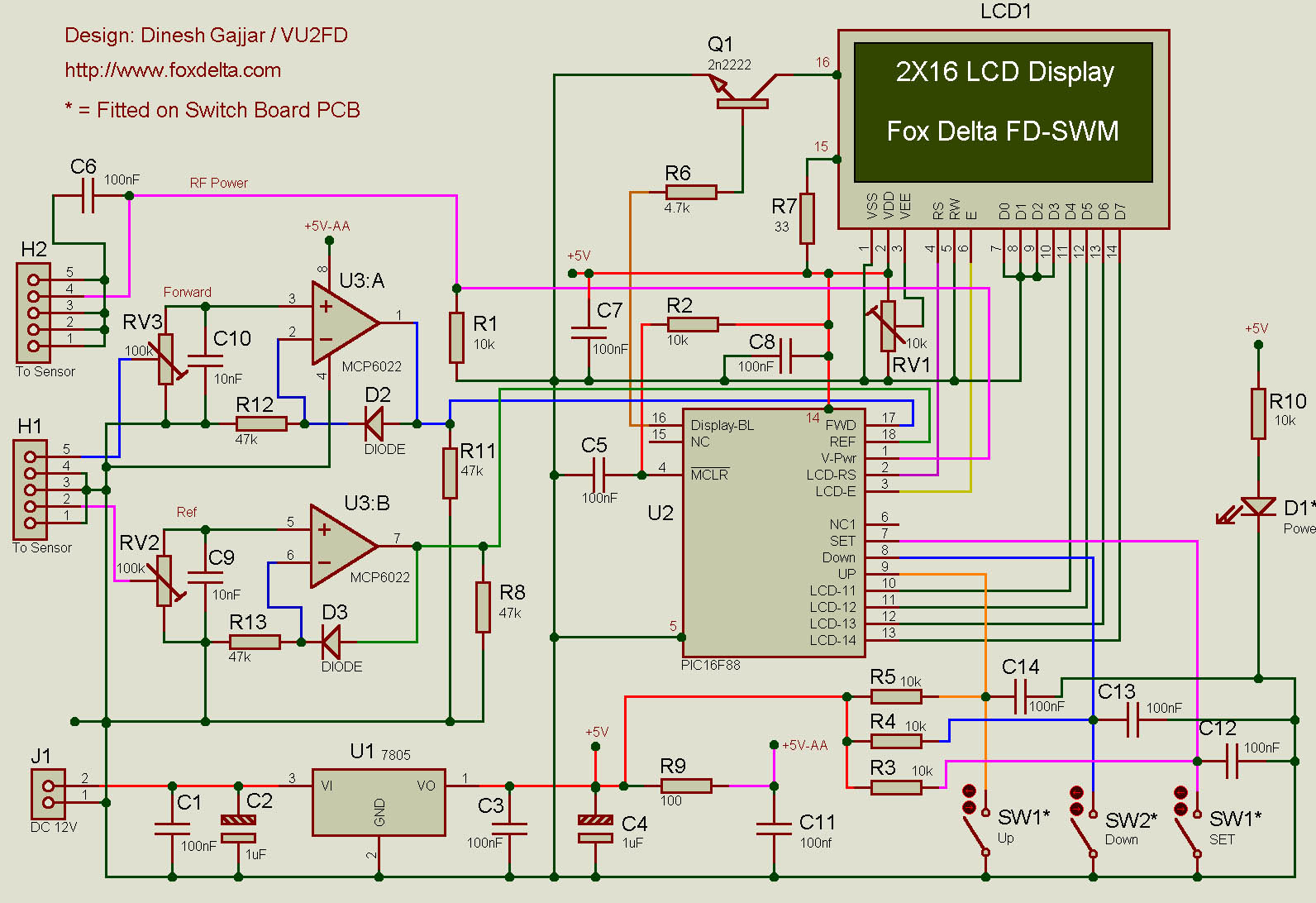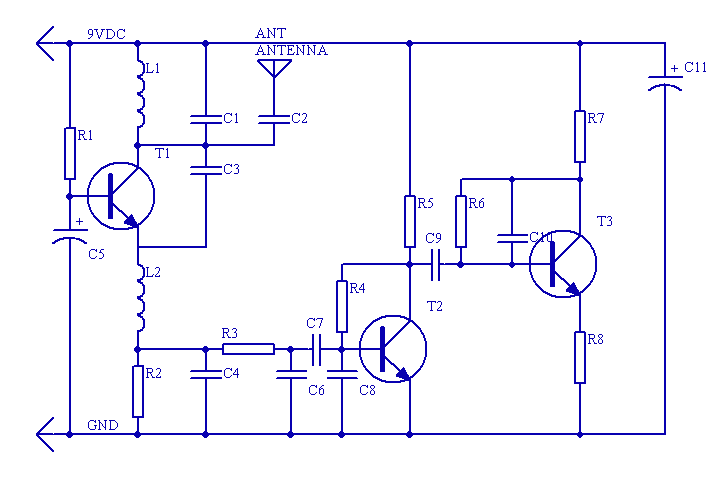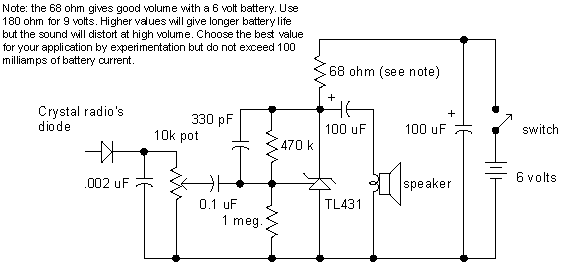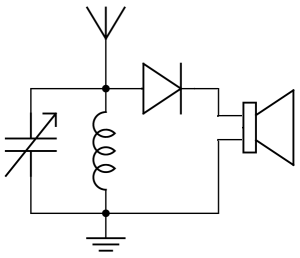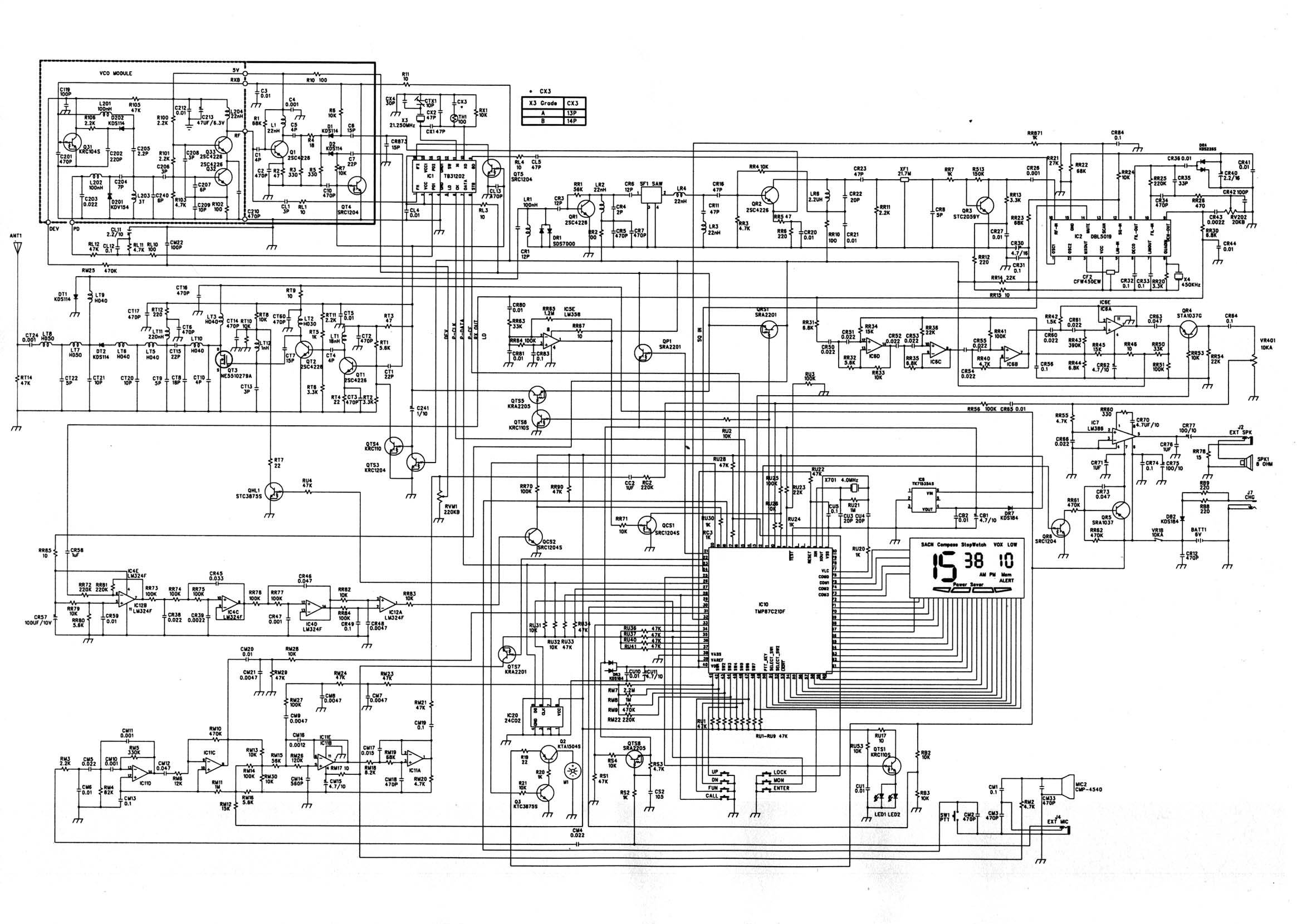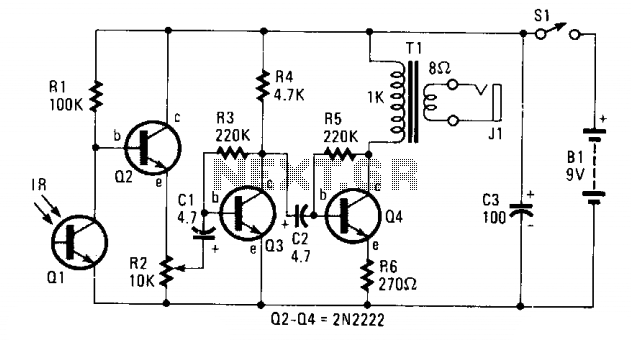
AM Radio Receiver
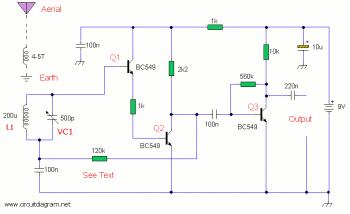
The AM radio receiver circuit diagram is based on the single integrated circuit MK484. The components list includes: R9, R10 (6.8 ohms), R6 (100 ohms), R3 (1k ohms), R1 (4.7k ohms), R7 (5.6k ohms), R4 (10k ohms), R2 (100k ohms), R5 (150k ohms), R8 (820k ohms), and a 10k logarithmic potentiometer. The circuit utilizes a coil and ferrite bar set, with capacitors C7 (470pF ceramic), C4, C5, C6 (each 470nF monoblock), and C2 (100nF). This circuit functions as a tuned radio frequency (TRF) receiver for standard amplitude modulation (AM) radio broadcasts, operating within the frequency range of 550kHz to 600kHz. It is designed to be simple and easy to construct, utilizing only two integrated circuits (ICs) and requiring a 9V power supply, which can be provided by a standard 9V battery. Additionally, the circuit features an active antenna suitable for FM, AM, and shortwave (SW) radio receivers. In the shortwave band, this active antenna is comparable to a 20 to 30-foot wire antenna. The design is particularly intended for receivers that employ untuned wire antennas, such as low-cost units and car radios. Furthermore, the description mentions a wireless car alarm system constructed from two modules: a transmitter and a receiver, operating on FM radio waves. This system can be used in vehicles with a 6-12V DC power supply, and a voltage stabilizer can be utilized if the car's power supply is excessive. The circuit also includes a very simple FM receiver built with a single transistor, without any additional chips or active components. The output can be connected to earphones, and an amplifier circuit is necessary for listening through a loudspeaker. The part designators include C1a and C1b (10pF, 50V ceramic disc capacitors) and C2 (22).
The AM radio receiver circuit employing the MK484 IC is an efficient design for receiving amplitude modulation signals. The use of a minimal number of components, including resistors with specified values and capacitors, facilitates straightforward construction and troubleshooting. The circuit operates effectively within the specified frequency range, making it suitable for various AM radio stations.
The active antenna enhances reception capabilities, particularly beneficial in areas with weak signals. The design allows for compatibility with untuned wire antennas, thereby increasing its usability in inexpensive radio models and car radios, which often lack sophisticated antenna systems. The circuit's power requirements are modest, enabling it to run off a standard 9V battery, making it portable and convenient for various applications.
In addition to its primary function as an AM receiver, the circuit can be adapted for use in a wireless car alarm system. The integration of transmitter and receiver modules allows for effective communication over FM radio waves, providing a reliable security solution for vehicles. This versatility is a key advantage, as it allows the same basic circuit design to be employed in different applications, from radio reception to vehicle security.
The simplicity of the FM receiver design, which utilizes only a single transistor, underscores the potential for compact and efficient radio circuits. This design is particularly useful for educational purposes, as it demonstrates fundamental radio principles without the complexity of multiple active components. The output configuration allows for easy connection to earphones or amplification systems, catering to various user preferences for audio output.
Overall, the circuit design exemplifies a practical approach to radio technology, allowing enthusiasts and beginners alike to explore the fundamentals of radio frequency reception and transmission.Here the AM Radio receiver circuit diagram based on old single IC MK484. Components part list: R9, R10_ 6R8 R6_ 100R R3_ 1K R1_ 4K7 R7_ 5K6 R4_ 10K R2_ 100K R5_ 150K R8_ 820K Pot_ 10K log pot Coil & ferrite bar set C7_ 470p ceramic C, C4, C5, C6_ 470nF monoblock C2_ 100nF. This circuit is a tuned radio frequency (TRF) receiver of the standard AM (amplitude modulation) radio with broadcast frequencies at 550kHz-600kHz. This is a simple and easy to build AM radio circuit which only using two integrated circuits (IC). This circuit works with 9V voltage supply, you could use 9V standard battery to cupply this. This is an active antenna for FM radio receiver, AM radio receiver and SW (shortwave) radio receiver. On the shortwave band this active antenna is comparable to a 20 to 30 foot wire antenna. This circuit is designed to be used on receivers that use untuned wire antennas, such as inexpensive units and car radios.
. This circuit is a wireless car alarm system that is built using two circuit modules, namely modules of transmitter and receiver modules. This circuit works on FM radio waves. Car alarms can be used on vehicles that have a 6-12VDC power supply. You can use the voltage stabilizer if your car power supply is too. This is a very simple FM receiver which build based on one transistor only. No chip or another active component. The output is connected to earphones, you need an amplifier circuit if you want to listen the radio with a loudspeaker.
Part designator Part description C1a, C1b 10 pf, 50 v, ceramic disc capacitor C2 22. 🔗 External reference
The AM radio receiver circuit employing the MK484 IC is an efficient design for receiving amplitude modulation signals. The use of a minimal number of components, including resistors with specified values and capacitors, facilitates straightforward construction and troubleshooting. The circuit operates effectively within the specified frequency range, making it suitable for various AM radio stations.
The active antenna enhances reception capabilities, particularly beneficial in areas with weak signals. The design allows for compatibility with untuned wire antennas, thereby increasing its usability in inexpensive radio models and car radios, which often lack sophisticated antenna systems. The circuit's power requirements are modest, enabling it to run off a standard 9V battery, making it portable and convenient for various applications.
In addition to its primary function as an AM receiver, the circuit can be adapted for use in a wireless car alarm system. The integration of transmitter and receiver modules allows for effective communication over FM radio waves, providing a reliable security solution for vehicles. This versatility is a key advantage, as it allows the same basic circuit design to be employed in different applications, from radio reception to vehicle security.
The simplicity of the FM receiver design, which utilizes only a single transistor, underscores the potential for compact and efficient radio circuits. This design is particularly useful for educational purposes, as it demonstrates fundamental radio principles without the complexity of multiple active components. The output configuration allows for easy connection to earphones or amplification systems, catering to various user preferences for audio output.
Overall, the circuit design exemplifies a practical approach to radio technology, allowing enthusiasts and beginners alike to explore the fundamentals of radio frequency reception and transmission.Here the AM Radio receiver circuit diagram based on old single IC MK484. Components part list: R9, R10_ 6R8 R6_ 100R R3_ 1K R1_ 4K7 R7_ 5K6 R4_ 10K R2_ 100K R5_ 150K R8_ 820K Pot_ 10K log pot Coil & ferrite bar set C7_ 470p ceramic C, C4, C5, C6_ 470nF monoblock C2_ 100nF. This circuit is a tuned radio frequency (TRF) receiver of the standard AM (amplitude modulation) radio with broadcast frequencies at 550kHz-600kHz. This is a simple and easy to build AM radio circuit which only using two integrated circuits (IC). This circuit works with 9V voltage supply, you could use 9V standard battery to cupply this. This is an active antenna for FM radio receiver, AM radio receiver and SW (shortwave) radio receiver. On the shortwave band this active antenna is comparable to a 20 to 30 foot wire antenna. This circuit is designed to be used on receivers that use untuned wire antennas, such as inexpensive units and car radios.
. This circuit is a wireless car alarm system that is built using two circuit modules, namely modules of transmitter and receiver modules. This circuit works on FM radio waves. Car alarms can be used on vehicles that have a 6-12VDC power supply. You can use the voltage stabilizer if your car power supply is too. This is a very simple FM receiver which build based on one transistor only. No chip or another active component. The output is connected to earphones, you need an amplifier circuit if you want to listen the radio with a loudspeaker.
Part designator Part description C1a, C1b 10 pf, 50 v, ceramic disc capacitor C2 22. 🔗 External reference
Warning: include(partials/cookie-banner.php): Failed to open stream: Permission denied in /var/www/html/nextgr/view-circuit.php on line 713
Warning: include(): Failed opening 'partials/cookie-banner.php' for inclusion (include_path='.:/usr/share/php') in /var/www/html/nextgr/view-circuit.php on line 713
